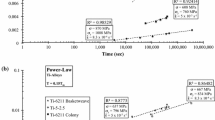Abstract
The creep rate of polycrystalline tin was studied as a function of temperature and stress in constant stress experiments. The temperature was varied from room temperature to almost the melting point of tin. Activation energies were calculated from tests run at the same stress. It was found that on a log creep rate vs inverse temperature plot the experimental points did not fall on one straight line but on a line which changed its slope in the 90° to 160°C region. Two activation energies for the creep of tin can be calculated from the data: ta value around 26,000 cal per mol at high temperatures and a value around 11,000 cal per mol at low temperatures. It is suggested that the discrepancies between the creep activation energies and those of self-diffusion can be accounted for if self-diffusion takes place predominately by Zener’s ring mechanism rather than through vacancy or interstitial movement.
Similar content being viewed by others
References
O. D. Sherby, R. L. Orr, and J. E. Dorn: Creep Correlations of Metals at Elevated Temperatures. Trans. AIME (1954) 200, p. 71; Journal of Metals (January 1954).
J. E. Dorn: Some Fundamental Experiments on High Temperature Creep. Inst, of Engineering Research Report University of California (1954) series No-22, issue No-35.
T. S. Ke: A Grain Boundary Model and the Mechanism of Viscous Intercrystalline Slip. Journal of Applied Physics (1949) 20, p. 274.
T. S. Ke: On the Structure of Grain Boundaries in Metals. Physical Review (1948) 73, p. 267.
P. J. Fensham: Self-Diffusion in Tin Crystals. Australian Journal of Scientific Research (1950) 3A, p. 91.
L. Rotherham, A. D. N. Smith, and G. B. Greenough: The Internal Friction and Grain Boundary Viscosity of Tin. Journal Inst, of Metals (1951) 79, p. 439.
K. E. Puttick and R. King: Boundary Slip in Bi-crystals of Tin. Journal Inst, of Metals (1952) 80, p. 537.
L. C. Tyte: The Rate of Viscous Flow of Metals: Part I, Tin. Proceedings Physical Soc, London (1938) 50, p. 11.
J. E. Breen: Creep Rupture Properties of Tin Tested at Constant Stress. Master’s Thesis, University of Maryland (June 1954).
R. E. Frenkel, O. D. Sherby, and J. E. Dorn: Activation Energies for Creep of Cadmium, Indium, and Tin. Inst, of Engineering Research Report University of California (1954) series No-22, issue No-36.
E. N. da C. Andrade: On the Viscous Flow in Metals and Allied Phenomena. Proceedings Royal Soc. (1911) 84, p. 1.
F. R. N. Nabarro: Deformation of Crystals by the Motion of Single Ions. Report of a Conference on the Strength of Solids. (1948) p. 75. London. Physical Soc.
C. Herring: Diffusional Viscosity of a Polycrystalline Solid. Journal of Applied Physics. (1950) 21, p. 437.
N. F. Mott: The Mechanical Properties of Metals. Proceedings Physical Soc, London (1951) 64B, p. 729.
C. Zener: Theory of Diffusion. Imperfections in Nearly Perfect Crystals. (1952) p. 289. New York. John Wiley and Sons.
N. F. Mott: Slip at Grain Boundaries and Grain Growth in Metals. Proceedings Physical Soc, London (1948) 60, p. 391.
Author information
Authors and Affiliations
Additional information
Discussion of this paper, TP 4015E, may be sent, 2 copies, to AIME by Jan. 1, 1956. Manuscript, Sept. 8, 1954. Philadelphia Meeting, October 1955.
This paper is based on a portion of a thesis by J. E. Breen submitted, in partial fulfillment of the requirements for the degree of Master of Science, to the University of Maryland.
Rights and permissions
About this article
Cite this article
Breen, J.E., Weertman, J. Creep of Polycrystalline Tin. JOM 7, 1230–1234 (1955). https://doi.org/10.1007/BF03379034
Published:
Issue Date:
DOI: https://doi.org/10.1007/BF03379034




